Master Triangle Pose (Trikonasana): Expert tips for perfect alignment, benefits, and variations

Triangle Pose (Trikonasana) is one of the first postures I teach to beginners, and while it may seem simple at first, its impact on balance, flexibility, and strength is profound.
This pose is often underestimated, but when done correctly, it provides deep physical and mental benefits.
In this detailed guide, I will walk you through the proper technique, variations, and the many benefits of Trikonasana. Whether you’re new to yoga or looking to refine your practice, my expert insights will help you enhance your body awareness, improve alignment, and challenge yourself in new ways.
Mastering this pose is key to unlocking greater strength and flexibility in your practice.
Key Takeaway:
Triangle Pose (Trikonasana) is a powerful foundational yoga posture that strengthens and stretches multiple muscle groups, enhances balance, and promotes mental clarity.
Regular practice not only improves flexibility, especially in the hips, shoulders, and spine, but also stimulates key chakras for emotional balance and creativity.
Whether you’re a beginner or seasoned practitioner, incorporating variations and modifications of Trikonasana into your practice can lead to improved posture, grounding, and overall well-being.
What is triangle pose (Trikonasana)?
Translated from Sanskrit, Trikonasana is a compound of trikona (meaning “triangle”) and asana (meaning “seat” or “pose”).
The name indicates a triangle shape you form with your body, creating a structure of stability and strength.
This foundational yoga pose stretches and strengthens multiple muscle groups, including the hamstrings, groin, and spine, while improving balance and focus.
Did you know? Triangle Pose is not only a great physical stretch but also serves as a powerful energetic asana. It engages the Root, Heart, and Sacral Chakras, promoting grounding, emotional balance, and creativity.
Benefits of triangle pose
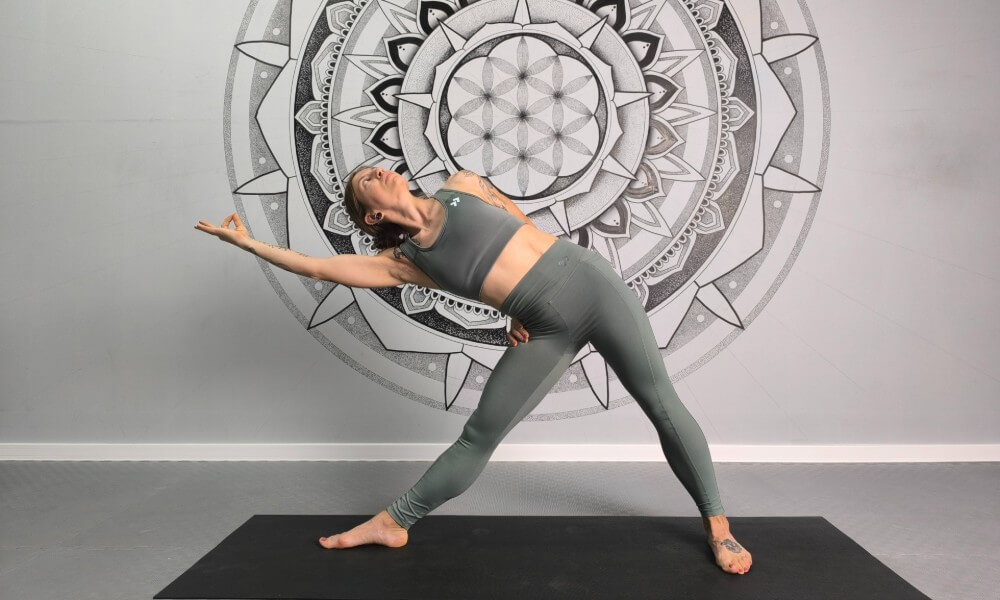
- Engages multiple hip muscles. Triangle Pose targets the hamstrings, groin, quads, and glutes. It provides a deep stretch for the back of your legs while also cultivating strength and stability in various muscle groups.
- Long and strong spine. The lengthening and rotation of the torso provide a deep stretch along the side of the body and help to strengthen the muscles supporting the spine.
- Improves balance. By engaging the core and leg muscles, the pose improves balance, helps develop better movement control and coordination.
- Opens the chest and shoulders. In Trikonasana, the arms are wide open, expanding the space between shoulders, shoulder blades and collarbones. It’s a great way to broaden all around your torso.
- Enhances flexibility: Regular practice of Triangle Pose can increase flexibility, especially in the hips, shoulders, and spine.
- Stimulates multiple chakras. The strong foundation of your legs helps ground the Root Chakra, which is associated with feelings of safety and security. By stretching the chest and ribs, Triangle Pose engages the Heart Chakra, promoting feelings of love, compassion, and emotional balance. The active hip rotation connects us to the Sacral Chakra, enhancing creativity, sensuality, and emotional expression.
- Improves mental clarity: The focus required to maintain alignment can help clear the mind, allowing for greater awareness. Triangle Pose is a great way to release tension and quiet a wandering mind.
How to perform triangle pose (Trikonasana)
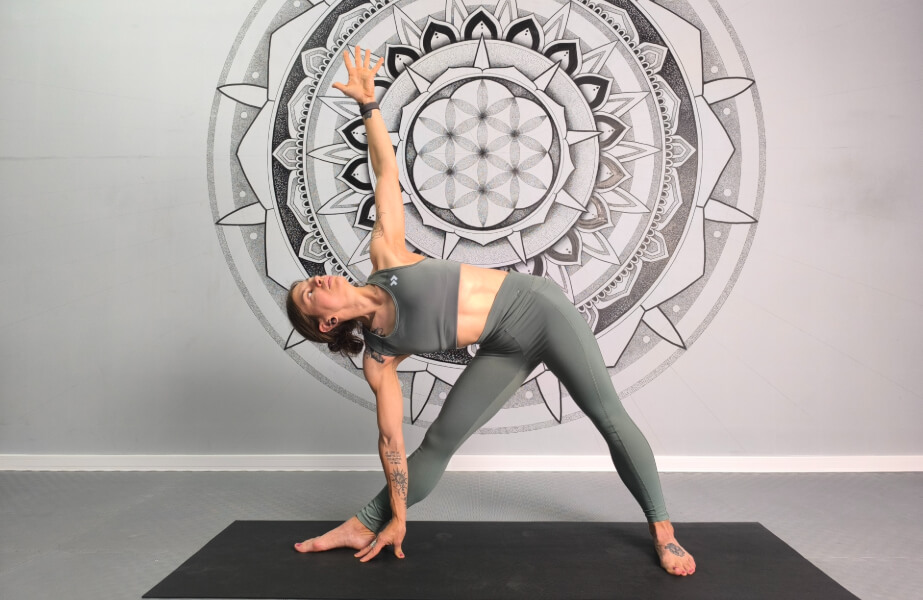
Here’s a step-by-step guide to ensure you’re practicing Triangle Pose safely:
- Start in Mountain Pose (Tadasana): Stand tall with your feet together, facing the long edge of your yoga mat.
- Set a stable foundation: Step your feet 3-4 feet apart. Angle your right foot forward (to the short edge of your mat) intersecting the left heel or arch.
- Establish your arms: Reach your arms wide, parallel to the floor with your palms facing down.
- Hinge at the hips: As you exhale, begin to hinge sideways toward your right leg, reaching your spine and crown parallel to the floor.
- Stability and balance: Place your right hand on the floor, inside of your shin, or a block. Extend your left arm directly upward, forming a straight line from hand to hand.
- Rotation and gaze: While your right hip stays open, rotate your pelvis and ribs to your left. Keep your neck long and gaze upward to your left hand.
- Hold Trikonasana: Stay in the pose for 3-5 breaths. Find stability through your feet and strength in your core.
- Repeat: Inhale to lift your torso, and turn your feet to the opposite edge of your yoga mat. Repeat on the other side.
Breathing and focus
Remember to use your breath in Trikonasana. Inhale as you lengthen your spine, and exhale as you deepen into the stretch. Focusing on your breath helps to maintain calm, allowing the mind and body to connect fully.
Common mistakes to avoid in triangle pose
To avoid strain and make the most of the pose, watch out for these common mistakes:
- Do not square down: Long spine is crucial. If you find yourself rounding your back and turning towards the floor, use a block or place your hand higher along your lower leg.
- Do not overstretch: While Trikonasana is meant to stretch the hamstrings, overextending the knee can lead to injury. Press down through the big toe mound of your front foot and engage the knee.
- Do not sink down: At every moment, try to find a sense of lightness in the top arm. Avoid dumping all the weight into your bottom hand. Your weight should be evenly distributed between both feet for balance.
- Do not strain your neck: Make sure your neck is long and in line with the rest of the spine before you introduce rotation. If looking up strains your neck, adjust by looking in a more neutral direction.
Modifications and variations
My favorite thing about the Triangle Pose is that it can be adapted to suit different levels and intentions. Here are a few common variations:
- Adjust the foundation. Depending on your height, flexibility, and yoga experience, you may set your feet wider or closer together.
- Bend your knee. Beginners can practice Triangle Pose with a slightly bent front knee, especially if hamstring flexibility is limited.
- Trikonasana with a chair. Place a chair at the front of your yoga mat, facing away from you. For better balance and stability, extend your bottom hand to rest it on the back of a chair.
Trikonasa with Blocks
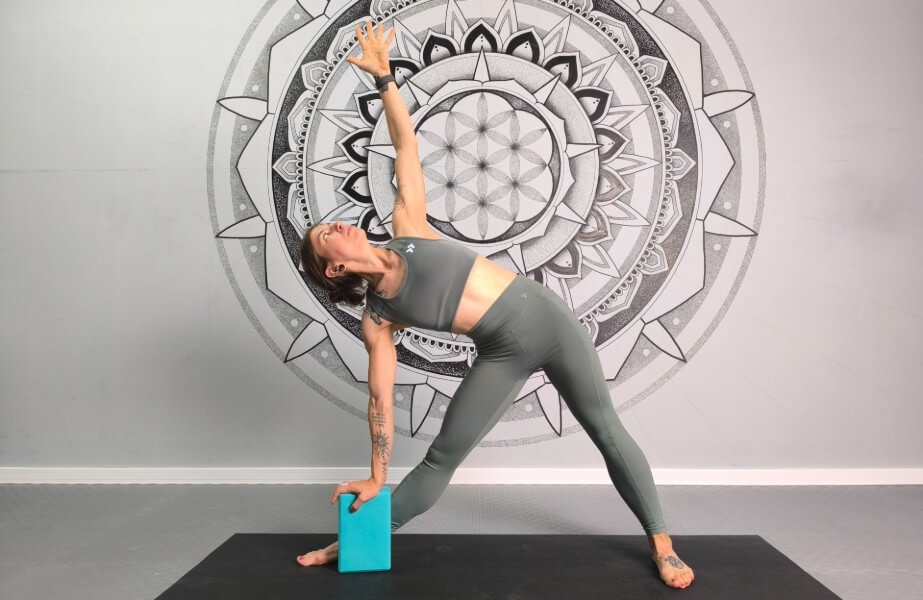
Place a yoga block under your bottom hand for support if you’re unable to reach the floor. This can help with alignment and reduce strain.
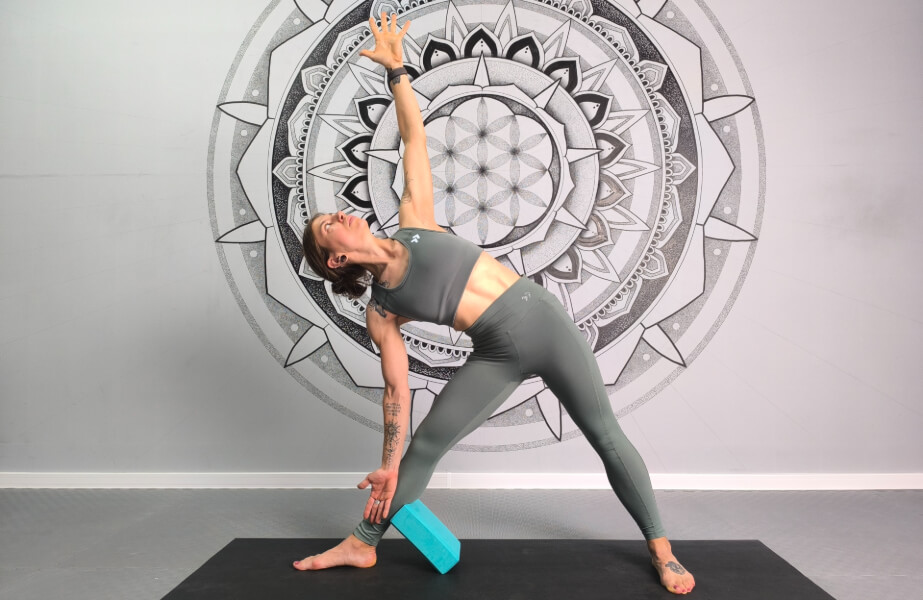
Similarly, you can place a block under your calf to stop the knee from overextending.
Bound Triangle Pose (Baddha Trikonasana)
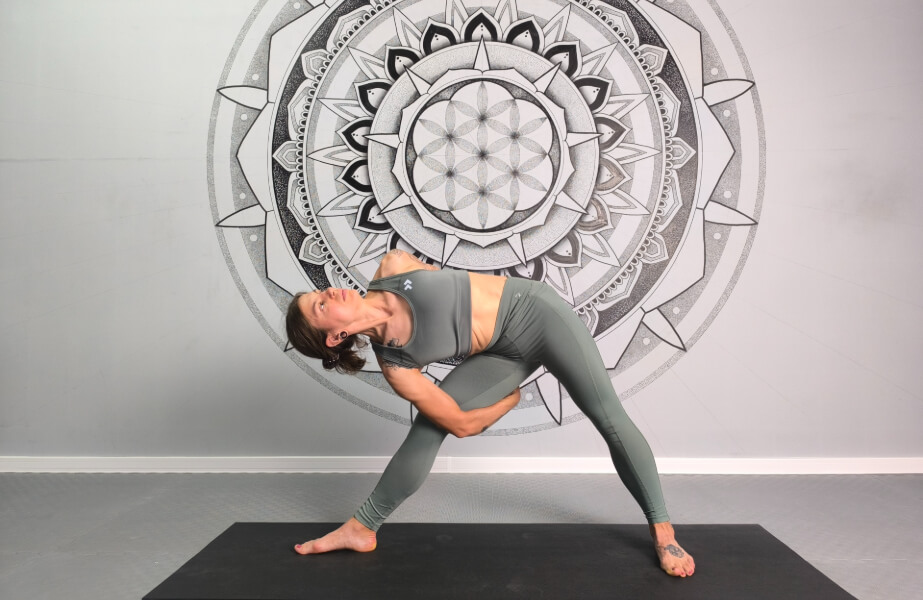
If you’re ready for a challenge, try an advanced variation where you bind one or both of your arms behind your back.
Revolved Triangle Pose (Parivrtta Trikonasana)

For a deeper twist, try Revolved Triangle. From Triangle Pose, rotate your torso toward the front leg and extend your opposite arm towards the ceiling.
Also read >>> Baki Pose – How to Master the Viral One-Arm Stance
Triangle pose in your yoga practice
Triangle Pose is not only a useful stand-alone pose but also an important part of many yoga sequences. It can serve as a transition between other standing poses like Warrior II and Extended Side Angle Pose.
Additionally, Triangle Pose can be included in flows to increase flexibility, promote grounding, and balance energy.
For practitioners with tight hamstrings, athletes, or yoga “newbies”, Triangle Pose provides an excellent foundation for building strength and improving posture. It is also therapeutic for relieving back and neck pain, and increasing energy levels.
Ready to practice triangle pose?
Take it slow and use appropriate modifications to ensure you maintain proper form. As you progress, you can deepen the stretch and try more challenging variations. Regardless of your practice level, Triangle Pose offers numerous benefits for your body, mind, and spirit.
Share your experience with Triangle Pose!
Tag us on social media with your practice and let us know how this powerful pose has helped you. Share your thoughts here below.

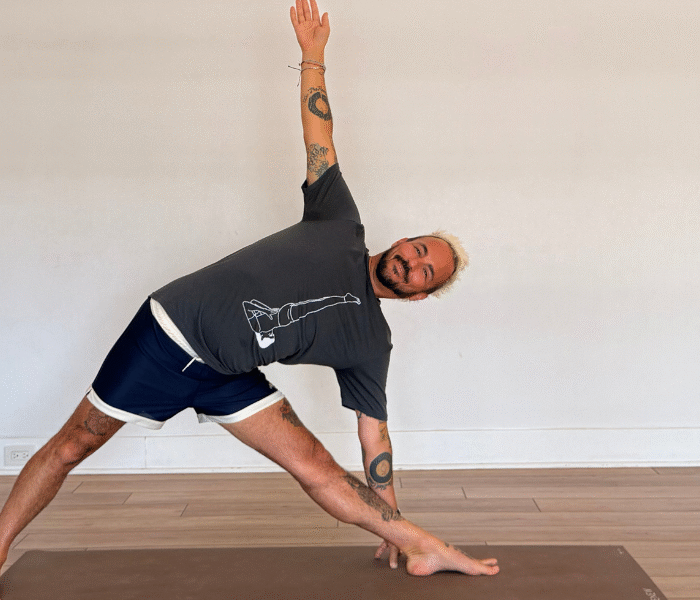
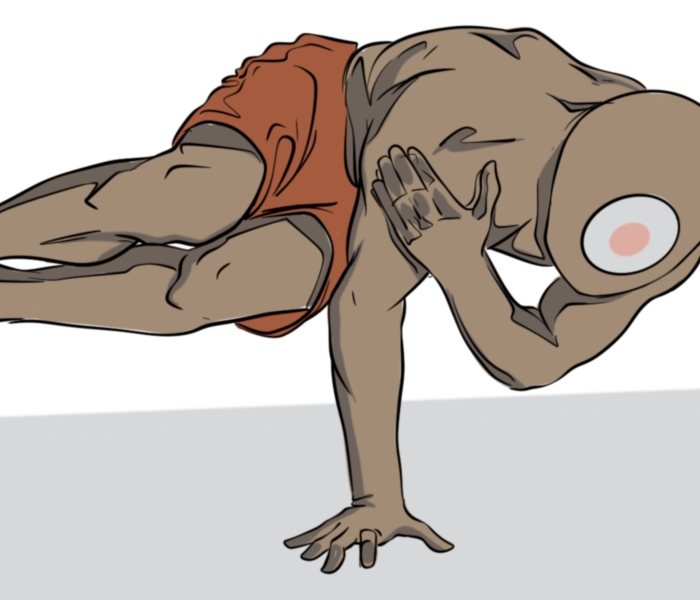
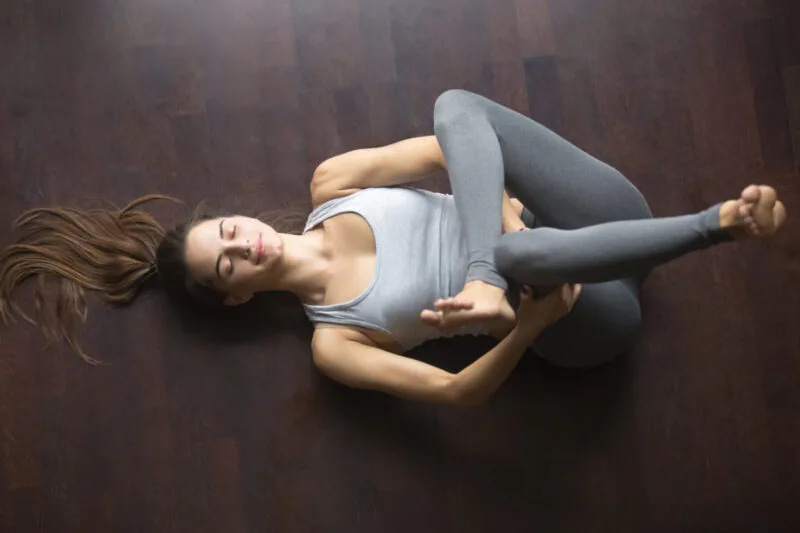


I never realized how much I was collapsing my side body in this pose until I read your tips. Tried it again today and actually felt stable and spacious at the same time. The advice about grounding the back foot really clicked for me.
It’s crazy how a few mindful adjustments can make the pose feel so alive instead of just a stretch.
“Wow I tried the trikonasana after reading your article and omg… my whole side body felt sooo open. I didn’t think my hamstrings could handle it but turns out they just needed a lil’ love.
I probly wobbled a bit but the way you explained grounding thru the feet really helped.
Feels like I found more space to breathe in my ribs. Def gonna add this to my morning flow, thx for sharing in such a chill way!
I tried some of the alignment tips you shared and wow, what a difference. I always thought my triangle pose was solid, but focusing on the length through both sides and keeping my chest open made it feel totally new.
I noticed I could breathe deeper and hold the pose without straining. It’s cool how small tweaks can shift the whole experience. Can’t wait to keep practicing it this way
“I’ve been doing triangle pose for years but honestly never paid attention to half the details you shared here. The cues about lengthening both sides and grounding through the back heel totally changed how it feels in my body. It went from a stretch to something way more balanced and alive. I’m gonna revisit my practice with these tips and see how much deeper I can go without forcing anything.
I had no idea Triangle Pose could help with back and neck pain. I’ve been struggling with stiffness from sitting at a desk all day, so I’m going to add this into my evening routine.
Your “don’t sink down” tip hit home. I used to collapse into my bottom hand, but today I engaged my core and spread weight evenly through my feet. Totally different sensation — stronger, more lifted, and way more balanced.
I love how you brought in the breathing aspect. I always forget to sync my breath in standing poses, but when I focused on lengthening the spine with the inhale and deepening with the exhale, it felt meditative instead of just physical.
I never thought about Triangle as a transition pose before. The way you explained it flowing between Warrior II and Extended Side Angle made me try it differently, and the sequence suddenly felt more fluid.
I’ve been practicing Revolved Triangle for a while and it’s always humbling. The twist feels so tight, but it really wakes up my whole back body. Thanks for including that variation here — it motivates me to keep working on it.
This guide reminded me of my very first yoga class. Triangle was one of the first poses I learned, and at the time I felt so clumsy. Years later, it’s become one of my anchors. There’s something about returning to the basics that feels grounding.
I didn’t know there was a bound version of Triangle Pose! Tried it and let’s just say… not quite there yet 😂 but it gives me something to work toward.
The mistake I always made was straining my neck. I’d push myself to look up even when it felt uncomfortable. Your suggestion to look neutral instead is a game changer. It makes me feel like yoga really is about listening to your body, not forcing shapes.
I’ve struggled with hamstring tightness for years, and bending the knee slightly made such a difference. I always thought bending was “cheating,” but now I see it’s actually smarter alignment. My body thanked me for not forcing it.
Honestly, I used to skip Triangle Pose in flows because it felt “boring.” But after learning about its impact on balance and mental clarity, I’m rethinking it. Not every pose has to be flashy — sometimes the simple ones are the most powerful.
The step-by-step instructions here were super clear. I practiced along while reading, and the cue about hinging at the hips instead of just reaching down really changed everything. Suddenly my spine stayed long and the stretch felt deeper but safer.
The connection to chakras is something I’ve never considered before. I usually just see Trikonasana as a stretch for the legs, but linking it to Root, Heart, and Sacral chakras makes sense. No wonder I feel calmer and more grounded after holding it for a few breaths.
I’ve always thought of Triangle Pose as “easy,” but reading this guide made me realize I’ve been doing it wrong for years. I always dumped weight into my bottom hand and wondered why my back felt tight afterward. Tried it your way today and it was a whole different experience — lighter, more open, and strangely energizing.
The way you described the dual coastlines gave me goosebumps. I actually split my time between the Pacific and Caribbean sides during my stay. It’s wild how different the energies are — one side rough and fiery, the other calm and dreamy. Practicing yoga in both places made me realize how much the environment mirrors what’s inside of us.
Reading this took me back to my own YTT in Costa Rica. I remember being so intimidated at first — new country, new people, long days that started before sunrise. But by week two, I felt like I’d stepped into a different version of myself. The jungle noises at night, the ocean in the distance, and the support of my group made it feel like home. Costa Rica has a way of holding you through transformation.